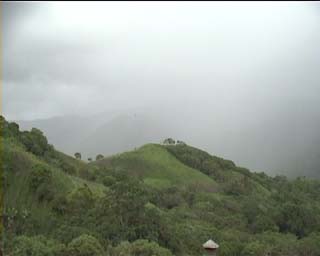

h|u|m|b|o|t
[about]
[+] next
[-] previous
[f] found entries
[w] word entries
[V] unfold
[x] close
| [x] |
Between the mouths of the Padamo and the Mavaca the Orinoco receives the Ocamo from the north, into which flows the Matacona river. At the source of this last river live the Guainare Indians, far less copper-colored or brown than others in this region. This tribe belongs to what missionaries call 'fair Indians' or Indios blancos. Near the mouth of the Ocamo travelers are shown a rock that is the marvel. It is granite passing into gneiss, characterized by its black mica, which forms little ramified veins. Spaniards call this rock Piedra Mapaya (Map Rock). I chipped off a bit. |
| [x] |
This hope was not totally justified. The youngest passenger attacked by the malignant fever was unluckily the only victim. He was a nineteen-year-old Asturian, the only son of a widow without means. Several circumstances made the death of this sensitive and mild-tempered youth moving. He had embarked against his will; his mother, whom he hoped to help through his work, had sacrificed her tenderness and own interests in order to assure the fortune of her son in the colonies, helping a rich cousin in Cuba. The luckless youth had fallen from the start into a total lethargy, with moments of delirium, and died on the third day. Yellow fever, or black vomit as it is called at Veracruz, does not carry off the sick so frighteningly quickly. Another Asturian, even younger than he, never left his bedside and, more remarkably, never caught the illness. He was following his compatriot to Cuba, to be introduced into his relation's house, on whom they had based all their hopes. It was desperate to see this young man abandon himself to deep grief and curse the advice of those who had sent him to a distant land, alone and without support. |
| [x] |
The treatment of the copper-colored Indians was accompanied by the same acts of inhumanity that later were meted out to the black Africans, with the same consequences of making both conquered and conquering wilder. From that time wars between the Indians became more common; prisoners were dragged from the interior to the coasts to be sold to whites who chained them to their boats. Yet the Spaniards at that period, and long after, were one of the most civilized nations of Europe. The light that art and literature shed over Italy was reflected on every nation whose language stemmed from the same source as that of Dante and Petrarch. One might have expected a general sweetening of manners as the natural consequence of this noble awakening of the mind, this soaring of the imagination. But across the seas, wherever the thirst for riches led to the abuse of power, the nations of Europe have always displayed the same characteristics. The noble century of Leo X was marked in the New World by acts of cruelty that belonged to a barbaric past. |
| [x] |
Every day we went botanizing in the Turbaco forests from five in the morning until dark: these long walks would have been a delight in this fertile marshy soil if we had not been devoured by mosquitoes, zancudos, chigoes and numberless insects already described in the Orinoco part of this narrative. In the midst of these wonderful forests, smelling the flowers of the Crinum erubescens and Pancratium littorale, we often came across Indian conucos, little banana and maize plantations where Indians, ever ready to flee from whites, live during the rainy season. This taste for the jungle and isolation typifies the American Indian. Though the Spanish population has mixed with the Indian population in Turbaco, the latter display the same lack of culture as in the Guianan missions. Examining their farming tools, the way they build their bamboo huts, their clothes and crude arts, I ask myself what the copper race has earned by contact with European civilization. |
| [x] |
We spent only one day at San Fernando de Atabapo, despite the village, with its pirijao palms and their peach-like fruit, promising us a delightful refuge. Tame pauxis (Crax alector) ran round the Indian huts; in one of which we saw a very rare monkey that lives on the banks of the Guaviare. It is called the caparro, which I have made known in my Observations on Zoology and Comparative Anatomy. Its hair is grey and extremely soft to touch. It has a round head, and a sweet, agreeable expression. |
| [x] |
A little above the Davipe mission the Río Negro receives a branch of the Casiquiare whose existence is a remarkable phenomenon in the history of river branching. This branch emerges from the Casiquiare, north of Vasiva, under the name Itinivi; and after crossing a flat, virtually uninhabited country some 25 leagues long, pours into the Río Negro under the name of Río Conorichite. It seemed to me, near its mouth, to be 120 toises wide, and added large quantities of white waters to the black waters. Even though the Conorichite current is very fast, you shorten the journey from Davipe to Esmeralda by three days using this canal. It is not surprising to find a double communication between the Casiquiare and the Río Negro when you recall that so many American rivers form deltas when they meet other rivers. In this way the Branco and the Jupura pour into the Río Negro and Amazon through many branches. At the confluence with the Jupura there is another more extraordinary phenomenon. Before joining the Amazon this river, which is its main recipient, sends three branches called Uaranapu, Manhama and Avateprana to the Jupura, which is none other than its tributary. The Amazon thus sends its waters into the Jupura before receiving the waters of the latter back. |

